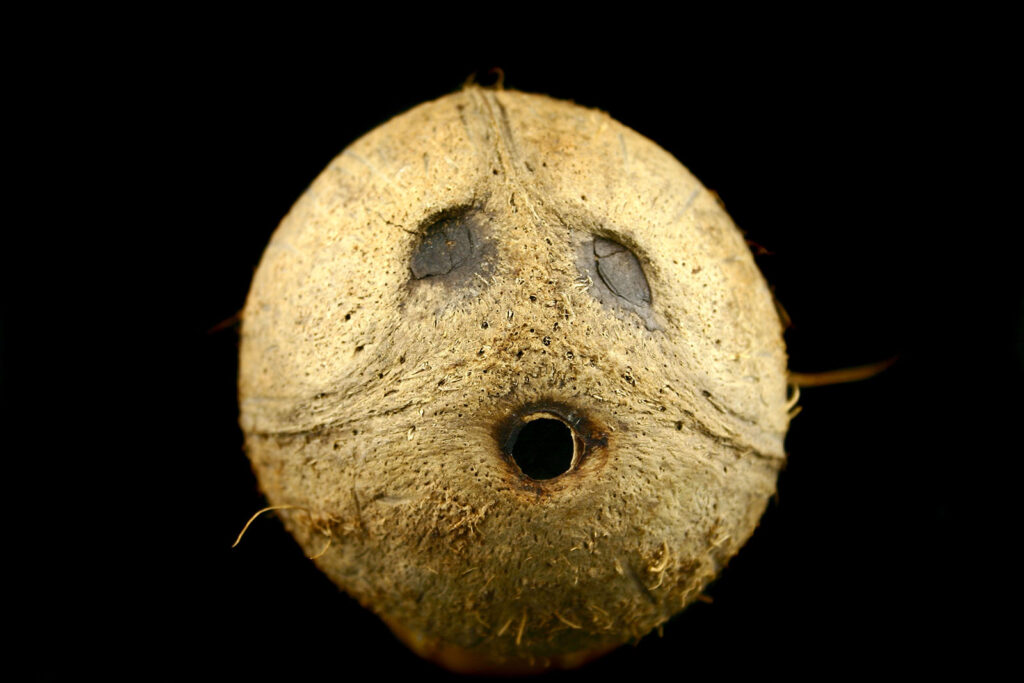
Not long ago, I wrote about how bogeyman-like legends exist almost all over the world. It’s stunning to know that nearly every culture on the planet has one. In many Spanish and Portuguese-speaking countries, there are tales of one of these, a mythical monster called El Coco (or El Cucuy). While some details vary from story to story, one thing seems consistent: El Coco eats children.
Behind the Names: El Coco, El Cucuy
El Coco, Coca, Cucuy, Cuco, Cuca, Cucu, Cucuí, El-Cucuí—as you can see, plenty of words are used to describe this particular monster. The name is thought to derive from various languages, particularly in northern Portugal and Galicia. The common theme across languages is that the word means “head” or “skull,” but the literal translation of most would be “coconut.” If you’ve ever seen a whole coconut, you can probably imagine why the word “coconut” is also used colloquially for “skull.”

You can listen to the pronunciation of two of the words here, so you can practice them at home: el coco & cucuy.
Everyone needs these words in their vocabulary because the last thing you want to do is look up a pronunciation guide when El Coco drags you off into the darkness.
El Coco’s Hunting Grounds
Murderous creatures from folklore or legend often stalk specific parts of the world. Unfortunately for us all, El Coco gets around by language and culture, so anywhere with people who speak Spanish, Portuguese, or Galician is susceptible to attacks by El Coco. I’ve taken the liberty of combining a few maps to create an “El Coco Danger Zone Travel Guide” so you can know where you might get eaten. Credit to Allice Hunter and Jonatan argento, CC BY-SA 4.0, via Wikimedia Commons for the original maps I used.

The Legend of El Coco
Glowing red eyes from under your bed or in your closet.
Mouth full of razor-sharp teeth like a barracuda.
A hairy beast atop the roof.
Long claws like knives.
Some say it is a vaguely female, humanoid alligator.
Or has an empty pumpkin for a head.
Some say it is the dark shadow of someone who recently died.
Whatever the form, the mere sight will paralyze you with terror.
The creature lives in a cave in the hills or mountains and uses one large, bat-like ear to listen for children misbehaving. It comes down from its den to stalk misbehaving children. El Coco snatches them up, tosses them into a bag, and whisks them back to its lair.
In the darkness, El Coco tears into the children, feasting on their flesh and leaving no trace of them behind.
Parents warn their children, “Behave, or El Coco will come and take you away.”
It is a tale told to children who want to go into dangerous places, those who do not listen to their parents, and those who don’t want to go to bed. You’ll notice that there are conflicting descriptions of El Coco and that the warning of “behave” could really take on nearly any meaning based on the parent.
As adults, whenever we encounter something like this, we inevitably ask: is El Coco real?
While you may read this and think that El Coco is simply a myth created by parents to keep their children in line, remember that countless children over centuries have been terrified by these brief stories and warnings. So, in children’s minds, El Coco is very real—no matter what you think.
Interestingly, there are legends of malevolent creatures in folklore that can only be seen by children. If you talk to adults who heard about El Coco when they were children, some have stories of close encounters with it. Somewhere, in the back of their minds, lies the stories of El Coco from their childhoods, still haunting their sleep.
Possible Origins of El Coco
The earliest known reference to “El Coco” comes from 1518 in “Auto da Barca do Purgatório”—an allegorical play written by poet and playwright Gil Vicente. The name “Auto da Barca do Purgatório” translates to “The Act of the Ship of Purgatory” and the use of El Coco is in reference to the devil. Sadly, I had trouble finding much in the way of Gil Vicente’s work available in English, but you can read more about him here and here on Project Gutenberg and even see photos of an original manuscript from him right here.
Gil Vicente wrote this over 500 years ago. Who knows where he got it from? But that means we have hard evidence from over 5 centuries ago of “El Coco” used to describe an evil being.
All of this bogeyman business, like in the case of El Coco, could be attributed to a simple tradition of parents using fear to scare their children into behaving. But that would mean the entire world spontaneously decided to scare their children into behaving using the same method. That seems a little unlikely.
Is there another reason why these bogeyman legends exist worldwide? Perhaps some folklore spread like wildfire across trade routes hundreds or thousands of years ago?
Or maybe there really were evils that lurked in the dark, waiting to eat children. But things like that can’t be real, right? You know, like Albert Fish, the American child serial killer cannibal dubbed “The Boogey Man.”